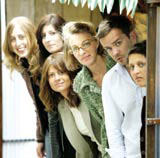A shop till they drop experience
If women are now making the retail decisions, it makes sense for retail interiors clients to go to a group with the necessary expertise, says Julie Oxberry

Household was nearly called The Rose and Crown. It sounds like a pub and the idea of adopting the qualities of a place that felt familiar, authentic and where people could feel at home, resonated with all of us.
As interior designers creating places and experiences for our clients, we wanted to be a place they would go out of their way for. For obvious reasons, last orders were called on the pub name and we opened for business as Household a year ago.
The starting point for us was our big design consultancy background – we have a history researching and designing retail experiences. From this foundation we are becoming recognised as specialists who design and build places where the brand meets the customer experience. This is an emotional exchange that relies on clear communications, using ‘stories’ that excite and enthuse customers, so they find what they want easily and stay longer. Most importantly, Household aims to create the kind of environment where customers can’t resist returning for more.
We believe this is the essential difference between a nicely designed interior and one that offers a differentiated customer experience that will provide the client with a greater return on their investment. This is key in the current retailing environment, where customers are fired up by price and are prepared to take it or leave it.
We call our first step to building a shop, bar or in-store experience ‘visual strategy creation’. Increasingly we find our clients wanting to work with this to bring their brand strategy alive. It’s a cost-effective way of creating something tangible right at the start of the project and it also secures internal buy-in to a new concept, while informing parallel initiatives.
So who are we? Household’s founding partners are all women. This was not a conscious decision, and to the world beyond the studio, it sometimes stimulates mild interest (usually on-site), whether this is good or bad, remains to be seen.
However, what we do know is that the high street has transformed massively over the past five years. And increasingly those driving the decisions on what to buy and how much to spend, are women. The way retailers connect and communicate with women is therefore fundamental.
So, our fashion clients appreciate that we are women designing spaces for women, and our DIY client sees us bringing design solutions that target the growing female decision maker in what has traditionally been a male-dominated environment. So in some cases, working in a consultancy that is mostly women has its advantages.
On a day-to-day level, it’s our smaller teams and the working process that gets everyone going – we ensure there’s always variety and this is what gets us out of bed and energised. On one day it could be an unusual shopping trip with a client, the next we’ve got our sleeves rolled up sketching on to walls, and the next we are briefing store roll-out teams on concept adaptation. This versatility enables us to work on many different scales of projects – from one-off boutiques, bars and office spaces to multi-national store chains.
That said, leaving behind a large company to create a smaller group also has its downsides. Having specialist skills in research and analysis, interior and graphic design, client relationship management and so on, does not necessarily stand you in good stead for un-jamming the paper in the printer or entertaining your clients while making five cups of tea. But beyond our core skills, sharing the vision and responsibility of the business – not just fulfilling our individual job roles – is the motivator for success.
So, where are we now? Our first year has been about setting up and getting started, benefiting from the good advice of our non-executive directors, who are experienced in the sector. We set out our stall, personal goals and targets – essentially, defined our reason for being. In this year we worked on profile projects with blue chip businesses, creating and contributing to stores that are exciting customers and commanding industry interest.
Year two is about laying down serious challenges for the business – raising our game. It is about discipline and client care. We are finding that the speed at which retailers need to get and keep people interested is accelerating. Hence solutions need to be innovative, smarter and cost-effective.
Julie Oxberry (pictured above, third from right) is managing director of Household
Household
• Founded in May 2004 by Julie Oxberry, Sarah Page, Michelle Du-Prât and Christine Sellwood
• The retail specialist sits inside the Mother consortium and shares Boots as a client, but is independent of the ad agency
• Additional team members are Keith Fowler, Sarah Peake, Andrew Revell and Ian Cochrane (non-executive director)
-
Post a comment



